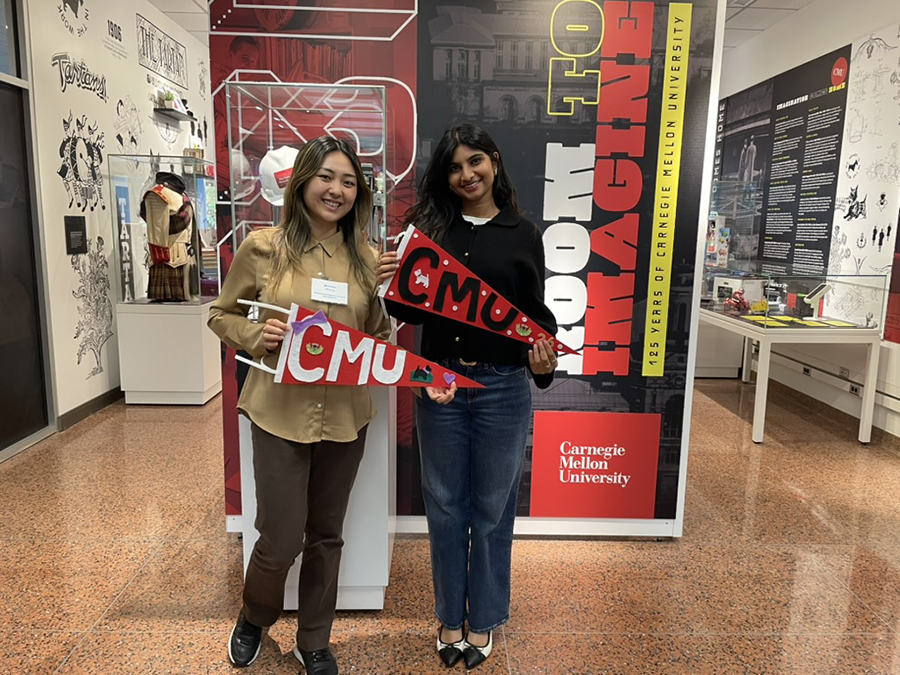Step into CMU's 125th anniversary exhibit, where a college dorm room reveals the hidden connections between everyday objects and world-changing discoveries.

By Brad King, anniversary exhibits and publishing managing editor
Julia Corrin knows Carnegie Mellon's impact on the world runs deep. As the university's archivist and associate dean for Distinctive Collections, she's spent years cataloging achievements and preserving institutional memory. But researching CMU's 125th anniversary exhibit continues teaching her something startling: she's still discovering innovations she never knew existed.
Her iPhone's intuitive gestures, from pinching to zooming to flicking between apps, trace back to Freddy Anzures (CFA 1999). Every swipe and tap relies on the Mach kernel developed by Professor Richard Rashid and Avie Tevanian (SCS 1985, 1988) in the 1980s. Even email attachments—the protocol everyone uses with the simple click of a paperclip icon—were invented here at CMU.
"The rhythm of your life, something that you do all day, every day, for work, would not be possible without CMU researchers," Corrin said.
That idea became the driving force behind "Room to Imagine," an immersive installation that opened this month in Hunt Library. It transforms a familiar college dorm room into a showcase of world-changing discoveries hidden in plain sight. Instead of showcasing the university's achievements in typical museum fashion, the exhibit invites visitors to uncover how Carnegie Mellon influences their daily lives. Popular Broadway and television melodies from CMU alumni composers and performers fill the air while screens display clips from films and TV shows created by our graduates. Computer demonstrations highlight the digital innovations and tech companies that first found life here on campus, while physical artifacts, prototypes, and memorabilia bring these stories to life. A companion newspaper rounds out the experience with alumni achievements spanning generations.
"At CMU, we often talk about the things that we do in very serious ways, and we wanted to make the things that CMU people have done understandable for a broad variety of visitors," Corrin said. "CMU is not a traditional school, so it seemed like going outside the box was the best way to celebrate 125 years."

Serendipity of Discovery
Some of CMU's most delightful contributions to daily life emerged from complete accidents. Take Silly Putty, that beloved childhood toy found in countless households. Few people know it originated when Earl Warrick (ENG 1933, 1934, 1943) tried to win World War II with better rubber and instead stumbled upon a gooey substance that bounced, stretched, and baffled visitors to his lab. His 1943 "bouncing putty" patent preceded the commercial Silly Putty by a year. These serendipitous discoveries reflect Carnegie Mellon's interdisciplinary DNA.
The university's greatest breakthroughs often began as solutions to immediate, practical problems and evolved through collaboration across departments. Artificial intelligence offers a perfect example: Herbert Simon and Allen Newell (TPR 1957), widely recognized as the "founding fathers" of AI, established Carnegie Mellon as the birthplace of modern AI research through practical problem-solving rather than abstract theorizing.
Working together since the RAND Corporation, they continued their partnership at Carnegie Mellon, developing the Logic Theorist in 1956, one of the first AI programs capable of proving mathematical theorems. When Simon wanted to bring Newell onto the faculty but couldn't without a doctorate, they built his PhD program around their ongoing research. Their collaboration earned them the Association for Computing Machinery's prestigious Turing Award in 1975. "Out of that comes artificial intelligence and the greatest computer science program in the world," Corrin noted.

Creating the “Room”
The exhibit itself emerged from CMU's collaborative spirit. The project brought together university staff with student designer Amanda Qian, whose fresh perspective proved invaluable for crafting an installation that speaks to multiple generations.
"She brought new energy to our team, she brought a fresh set of eyes," Corrin said. "When you collaborate often with the same group of people, you get so into your own shorthand and the assumptions that you have about the people you're working with that you lose sight of some things."
For Heidi Wiren Kébé, associate director of Creative, the collaboration highlighted the importance of hands-on experience in design work. She praised Qian's architectural background and spatial understanding, crucial for balancing physical artifacts with multimedia elements.
"She understands space, weight, scale, and design," Wiren Kébé said. "She proactively jumped to what I needed, because she understands what needs to happen next.

However, none of the work could have been done without the digitization lab and University Archives team members Emily Davis, Kathleen Donahoe, and Crystal Johnson, who provided crucial support by researching and scanning historical materials for the physical space.
"Room to Imagine" opens August 25 in Hunt Library and runs through July 10, 2026.
Visitors can take home a specially created alt-weekly newspaper featuring alumni achievements, or download it from the exhibit website. Extended content is available through a Spotify playlist featuring audio from the installation and a Bloomberg Connect mobile experience.
The exhibit is made possible through generous support from Michael Smith (ENG 1968) and Lonna Smith (CFA 1969), whose recent gifts supported the Hunt Library gallery buildout and fund exhibitions celebrating University Archives collections.
